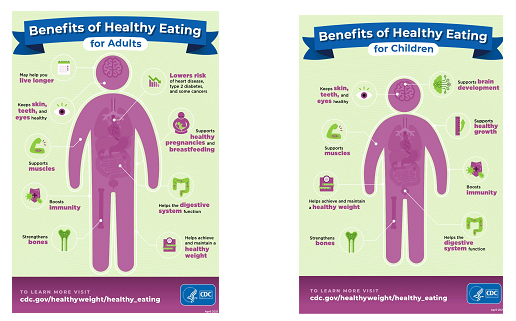Good nutrition is about consistently choosing healthy foods and beverages. Healthy eating patterns can include foods and beverages that reflect preferences, cultural traditions, and budgetary considerations. Healthy eating emphasizes fruits, vegetables, whole grains, dairy, and protein. Dairy recommendations include low-fat or fat-free milk, lactose-free milk, and fortified soy beverages. Other plant-based beverages do not have the same nutritional properties as animal's milk and soy beverages. Protein recommendations include seafood, lean meats and poultry, eggs, legumes (beans, peas, and lentils), soy products, nuts, and seeds.
Bump up fiber
Fiber helps maintain digestive health and helps us feel fuller longer. Fiber also helps control blood sugar and lowers cholesterol levels. Fresh fruits and vegetables, whole grains, legumes, nuts, and seeds are good sources of fiber.
Increase calcium and vitamin D
Calcium and vitamin D work together to promote optimal bone health. Our bodies can make vitamin D from sunshine. However, some people may have a hard time producing enough vitamin D. And too much sun exposure can increase the risk of skin cancer.
Add more potassium
Potassium helps the kidneys, heart, muscles and, nerves function properly. Not getting enough potassium can increase blood pressure, deplete calcium in bones, and increase the risk of kidney stones.
Limit added sugars
Too much added sugar in your diet can contribute to weight gain, obesity, type 2 diabetes, and heart disease. Added sugar are sugars and syrups that are added to foods and drinks when they are processed or prepared. Added sugars have many names, including cane juice, corn syrup, dextrose, and fructose. Table sugar, maple syrup, and honey are also considered added sugars. Sugary drinks are a common source of added sugar
Replace saturated fats
Replacing saturated fat with healthier unsaturated fats can help protect your heart. Common sources of saturated fat include fatty meats, full-fat milk and cheese, butter, and cream cheese. We need some dietary fat to give us energy, develop healthy cells, and help absorb some vitamins and minerals. But unsaturated fat is better for us than saturated fat.
    |
 |
| Figure 1. Fruits like avocado can provide healthy unsaturated fat in your diet. |
|
    |
 |
| Figure 2. Adding diced peppers and herbs to a dish boosts color and nutrients |
|
Cut back on sodium
Eating too much sodium can raise your risk of high blood pressure, heart attack, and stroke. More than 70% of the sodium Americans consume comes from packaged and prepared foods. While sodium has many forms, 90% of the sodium we consume is from salt.
Aim for a variety of colors
A good practice is to aim for a variety of colors on your plate. Fruits and vegetables like oranges, tomatoes, and dark, leafy greens—and even fresh herbs—are loaded with vitamins, fiber, and minerals.
Benefits of Healthy Eating for Adults
- May help you live longer.
- Keeps skin, teeth, and eyes healthy.
- Supports muscles.
- Boosts immunity.
- Strengthens bones.
- Lowers risk of heart disease, type 2 diabetes, and some cancers.
- Supports healthy pregnancies and breastfeeding.
- Helps the digestive system function.
- Helps achieve and maintain a healthy weigh
Benefits of Healthy Eating for Children
- Keeps skin, teeth, and eyes healthy.
- Supports muscles.
- Helps achieve and maintain a healthy weight.
- Strengthens bones.
- Supports brain development.
- Supports healthy growth.
- Boosts immunity.
- Helps the digestive system function.
    |
 |
| Figure 3. Benefits of Healthy Eating |
References
Centers for Disease Control and Prevention. Healthy Eating Tips. https://www.cdc.gov/nutrition/features/healthy-eating-tips.html